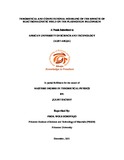| dc.contributor.author | Sackey, Juliet | |
| dc.date.accessioned | 2015-08-04T16:58:10Z | |
| dc.date.available | 2015-08-04T16:58:10Z | |
| dc.date.issued | 2011-12-15 | |
| dc.identifier.uri | http://repository.aust.edu.ng/xmlui/handle/123456789/262 | |
| dc.identifier.uri | http://library.aust.edu.ng:8080/xmlui/handle/123456789/262 | |
| dc.description.abstract | The study explores the potential effects of the remote application of cyclic magnetic field to the female anopheles mosquitoes that carry malaria parasites. The goal is to develop a theoretical basis that can guide the cyclic activation of the magnetic field to induce the inactivity of the malaria parasite without killing the mosquitoes. The model considers the hemozoin within the
malaria parasite as a cluster of magnetic nanoparticels. The potential effects of the applied magnetic field are then considered within a thermodynamic frame framework. The induced heat generated is computed implicitly within a combined analytical and computation approach. From our numerical analysis, we noticed that, an increase in the frequency with a strong magnetic field
causes heating of the magnetic nanoparticles. Experimentally, in a magnetic field induction of 0.3 T, the protein in the heme acquire enough energy to survive at a temperature of 24oC with a frequency of 4.2 kHz and the volumetric power dissipated of 956.6890W/m in 300 s window. A numerical simulation based on finite element scheme was employed to reaffirm this analysis. At a maximum temperature of 42oC, for 900s steady state, the bonds in the particle begin to break off destroying their tertiary structure as a result of the thermal agitation in a form of collision thereby losing it ability to stay inside the chamber. This therefore enables the release of the nanoparticle out of the chamber of the hemozoin into the plasmodium falciparum making it inactive of malaria transmission. The effects of the localised changes in temperature are discussed for potential applications in future devices that could be developed to render malaria parasites inactive of transmission of malaria. | en_US |
| dc.language.iso | en | en_US |
| dc.subject | Theoretical And Computational Modeling Of The Effects Of Electromagnetic Field On The Plasmodium Falciparum | en_US |
| dc.subject | Sackey, Juliet | en_US |
| dc.subject | 2011 | en_US |
| dc.subject | Theoretical Physics | en_US |
| dc.subject | Wole Soboyejo | en_US |
| dc.title | Theoretical And Computational Modeling Of The Effects Of Electromagnetic Field On The Plasmodium Falciparum | en_US |
| dc.type | Thesis | en_US |

